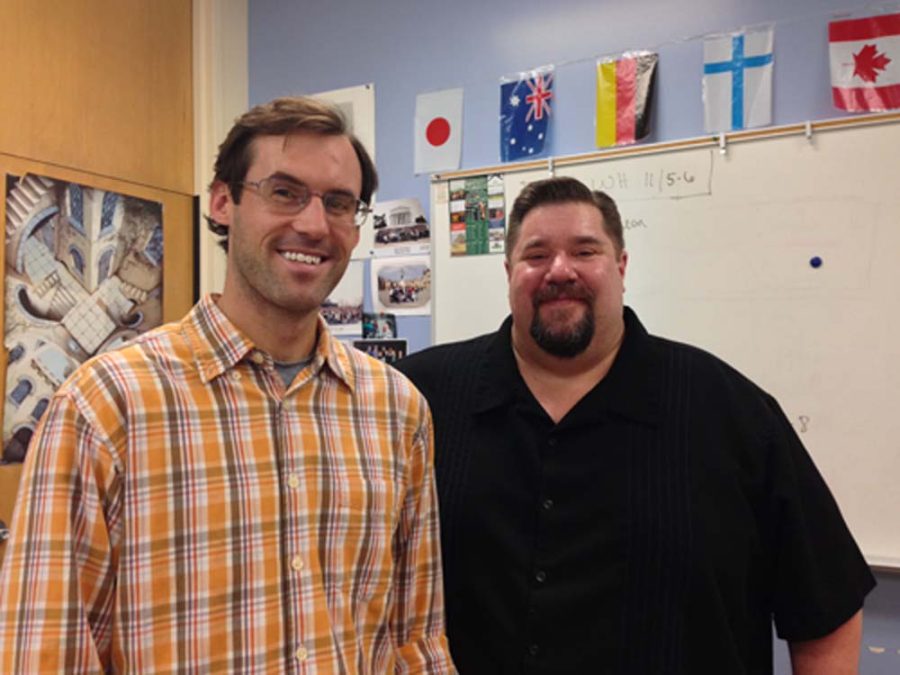Positive student response to special education integration
RIGHT: Social science and history teacher Chris Farina and special education teacher John Mackey take advantage of being able to co-teach . They believe that this policy has greatly benefitted their students.
Imagine a class where students take their seats and get ready to discuss last night’s homework. They push their desks to form discussion groups and hands go up to attract the attention of the teacher, but unlike most regular classes, this class has two different levels of learners and two teachers circulating the classroom and answering questions. There is more teacher aid, more participation among students and more unity in the class.
Three years ago, Palo Alto High School’s administration implemented a program to try and make that vision a reality. This program involves special education teachers working side by side with regular education teachers in classes to bring together the special and regular education students, give students more support and let everyone feel more comfortable in school.
Since the policy’s inception, an assortment of 11 classes ranging from math to science have both regular and special education students, the same number of co-taught classes held at Henry M. Gunn High School, according to principal Kim Diorio.
The instigation of these classes started as an effort to integrate different students into one class and to teach regular education teenagers about the importance of accepting others and creating a safe environment for peers inside and outside of school.
This idea of unity led to the annual district wide Unity Day, which was held on Oct. 9.
After having another instructor briefly teach with her last year, English teacher Melissa Laptalo reflects on her mostly positive experience in her co-taught class.
“I think that it is a very beneficial structure because in any classroom whether is it labeled honors, advanced or mainstream, special education there’s always a variety of skill level in the classroom,” Laptalo said. “So I think that the greatest benefit for co-teaching is having two instructors in the classroom because there’s more help to go around.”
Like teachers who are ecstatic about co-taught classes, students such as junior Margaret Schmit who has an integrated class also notice the difference in unity in their classes with special and regular education teachers.
“Well I think that it’s better [for classes] to be integrated than not integrated because it’s better for everyone to just to meet new people and not have segregation between special [education] and not special [education],” Schmit said. “I think special education teachers help that integration happen because it’s a lot of work and takes up a lot of time for normal teachers to accommodate for the special [education] kids.”
While some students find this plan to be useful, others do not even know about this dual teacher effort. The role of the teacher may be a little bit misleading since the special education teacher does not actually stand in the front of the room to teach. Instead, they pop in and out to assist the class and tend to the needs of the students.
“I think the special [education]teacher isn’t really a teacher,” Schmit said. “[The special education teacher is] more of an aid that helps out with the class and with the special [education] students. She’s helping the class in general but specifically the special [education] kids.”
With these new co-taught classes, regular education teachers do not need to put as much effort into working with the kids who need more attention, yet the special education students still receive the help and attention that they need. It is not exclusively beneficial to special education students. Though some may argue that having classmates who need more guidance slows down the class, others think that having unity within the class and getting students to understand the importance of accepting their peers is more essential.
The system gives special education and regular education students more necessary individual attention. There are always students in classes who would feel more comfortable not being put on the spot in front of the whole class, so having more teachers in the classroom can make those students feel more comfortable with asking questions and inputting ideas into discussions because there is more individualized attention.
“I think that having more than one teacher in the room just offered twice as much support for students than one teacher can give,” Laptalo said. “Every student has different talents and capabilities and so I think having the combined format allows students to showcase that regardless of what their strengths and weaknesses are.”
Your donation will support the student journalists of Palo Alto High School's newspaper

